Famous wooden structures around the world include historic sites like Japan’s Horyu Temple and Russia’s Kizhi Pogost, showcasing ancient craftsmanship and cultural significance. Modern marvels such as Norway’s Mjøstårnet and the USA’s Ascent push timber’s limits, while iconic bridges like Myanmar’s U Bein Bridge highlight durability. These structures blend tradition with innovation, demonstrating timber’s versatility. Explore further, and you’ll discover more about how wooden architecture continues to inspire and evolve across the globe.
Key Takeaways
- Iconic ancient wooden structures like Kizhi Pogost in Russia and Horyu-ji Temple in Japan showcase historical craftsmanship and cultural significance.
- Modern tall wooden buildings such as Mjøstårnet in Norway and HoHo Wien in Austria set world records for height and engineering innovation.
- Famous wooden bridges like Myanmar’s U Bein Bridge demonstrate durability and traditional craftsmanship in infrastructure.
- Unique wooden structures include cultural symbols like the Pagoda of Fogong Temple and the Pineapple House in Kumamoto.
- Innovative techniques like cross-laminated timber and advanced joinery enable the construction of large-scale and high-rise wooden buildings worldwide.
Ancient Religious and Cultural Wooden Buildings

Ancient religious and cultural wooden buildings showcase remarkable craftsmanship and spiritual significance. You’ll find these structures crafted from timber, highlighting traditional architecture’s ingenuity. The Horyu Temple in Japan, built around 600 CE using Japanese cypress, is the oldest surviving wooden temple and a UNESCO World Heritage site. In Russia, the wooden churches of Kizhi Island feature intricate craftsmanship with round logs, earning UNESCO recognition since 1990. China’s Pagoda of Fogong Temple, constructed in 1056 from oak logs, stands over 67 meters tall, exemplifying ancient pagoda design. These wooden structures served as sacred spaces—temples, churches, or pagodas—reflecting cultural identity and spiritual devotion. Their enduring preservation highlights the skill and devotion of early builders, making them timeless symbols of religious heritage. Traditional architecture also emphasizes the importance of craftsmanship and material selection, which contribute significantly to the longevity of these structures. Additionally, the use of durable materials like Japanese cypress or oak logs played a crucial role in their resilience over centuries. Moreover, the innovative use of timber joinery techniques contributed to their stability and ability to withstand natural elements over time. The mastery of joinery techniques allowed these buildings to remain standing for centuries, demonstrating the sophistication of ancient woodworking skills. The development of structural engineering principles in woodworking further supported their remarkable longevity and resilience.
Modern Architectural Marvels in Timber Construction
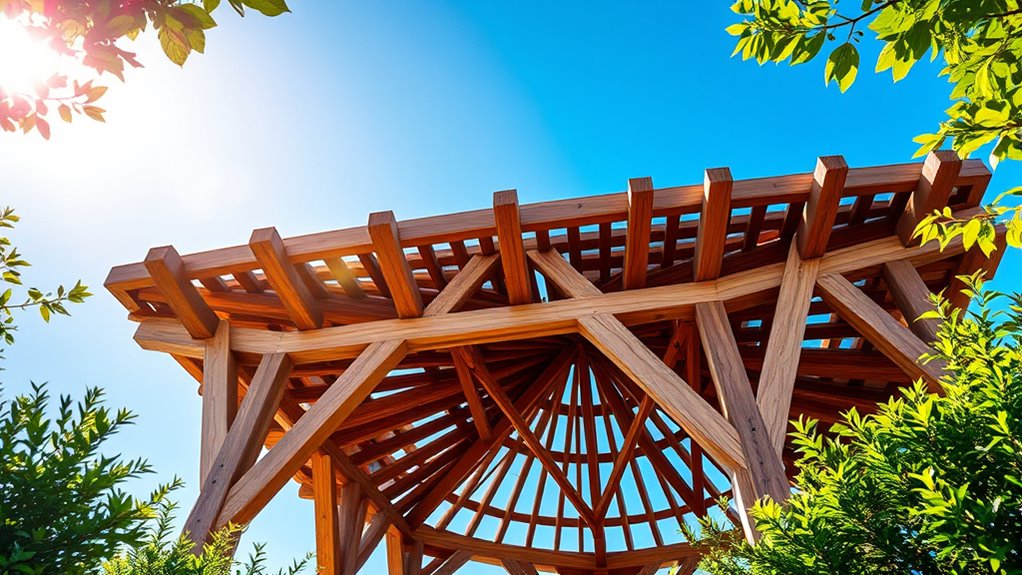
Modern timber construction has transformed the skyline with innovative designs and sustainable practices, proving that wood can rival traditional building materials in durability and scale. You’ll see impressive structures like high-rise skyscrapers built with cross-laminated timber (CLT), such as Ascent in Australia and Mjøstårnet in Norway, which demonstrate timber’s potential for tall, resilient structures. Architects are pushing boundaries with massive timber modules in buildings like Treet and HoHo Wien, highlighting eco-friendly and aesthetically striking designs. These projects utilize advanced engineering techniques, including prefabrication and buckling-restrained braces, to guarantee durability and earthquake resistance. Incorporating high SEER-rated systems can further enhance the energy efficiency of such buildings, making them even more environmentally friendly. As a sustainable material, timber is reshaping the architectural landscape, making towering, environmentally conscious structures a reality worldwide. Additionally, ongoing research into wood durability is expanding the possibilities for future timber innovations. For instance, innovations in timber treatment technologies are improving the longevity and resilience of wooden structures against pests and weathering. This progress is supported by the development of new building codes that facilitate the safe use of timber in larger-scale constructions. Moreover, advancements in engineered wood products are enabling the creation of more complex and load-bearing wooden structures, broadening design possibilities.
Record-Setting Wooden Structures Worldwide
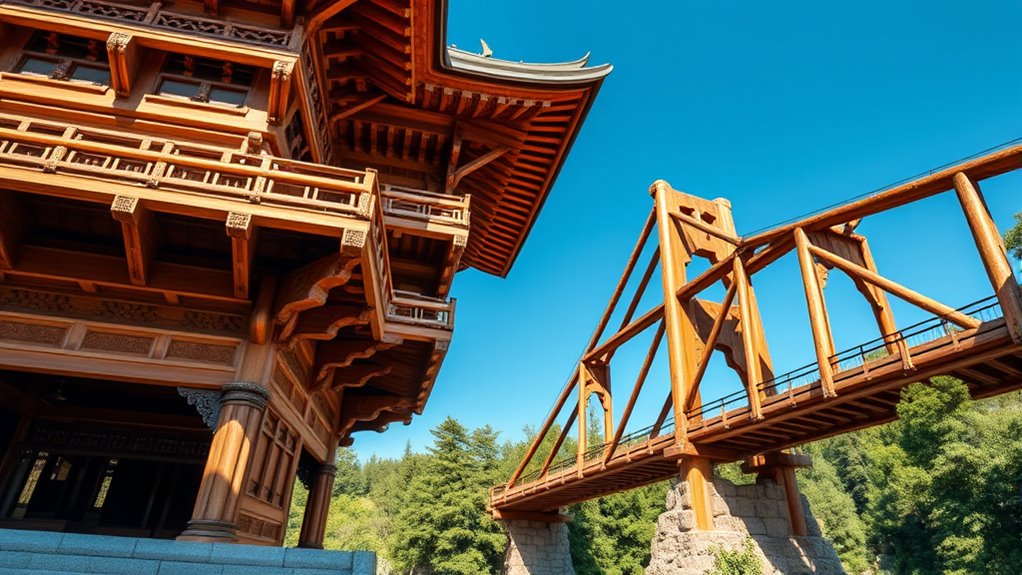
Across the world, wooden structures are setting remarkable height records that showcase the incredible potential of timber in architecture. The Gliwice Radio Tower in Poland, built in 1935, stands at 111 meters, making it the tallest free-standing wooden human-made structure. In more recent times, the tallest wooden building is Norway’s Mjøstårnet, reaching 85.4 meters using innovative mass timber techniques. Austria’s HoHo Wien, completed in 2019, stands at 84 meters, exemplifying modern timber construction. Vancouver’s Burrard Exchange, finished in 2023, is a 79.2-meter-high wooden office tower among North America’s tallest. Sweden’s Sara Kulturhus Centre, inaugurated in 2021, at 72.8 meters, highlights the creative use of timber architecture. These record-setting wooden structures demonstrate timber’s strength and versatility in building tall and sustainable. Innovative construction methods continue to push the boundaries of what is possible with timber in architecture, especially as sustainable building practices become more prevalent worldwide. Additionally, advancements in engineered wood products are enabling taller and more durable wooden structures than ever before.
Iconic Bridges and Infrastructure Made of Wood
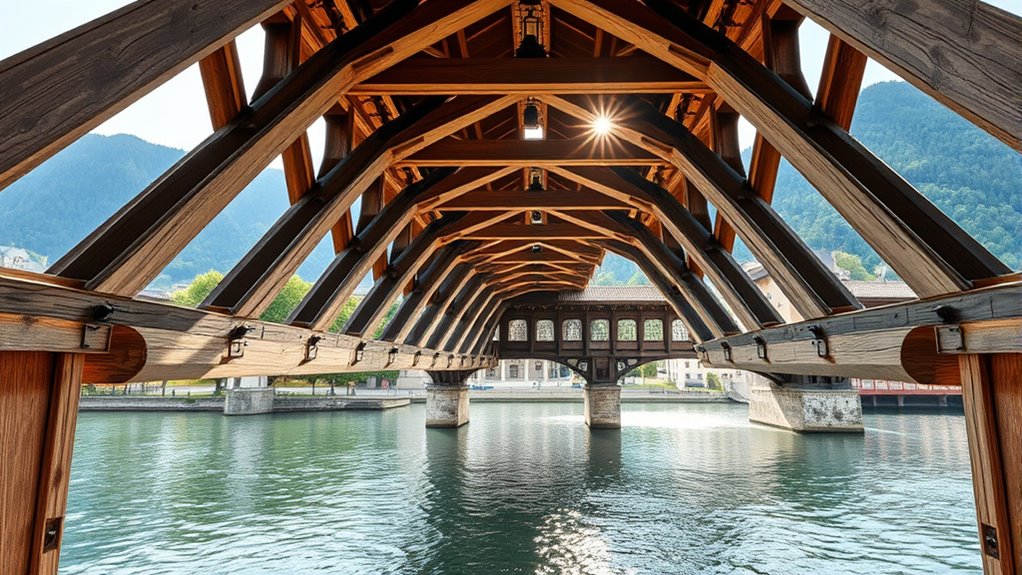
Wooden structures are not just about towering buildings; they also play an essential role in transportation and infrastructure. Wooden bridges, like Myanmar’s U Bein Bridge, showcase the beauty and strength of traditional craftsmanship. Constructed mainly from teakwood, these bridges benefit from its natural water resistance and durability, ensuring they withstand the test of time. Such wooden infrastructure highlights centuries-old engineering techniques that prioritize sustainable materials. These bridges often serve as scenic routes, connecting communities and attracting tourists while emphasizing the cultural significance of wood in transportation. Their design and longevity demonstrate how careful craftsmanship and natural materials can create functional, enduring infrastructure. Wooden bridges like U Bein stand as timeless examples of how wood continues to serve in iconic and practical ways around the world. Additionally, the preservation of these structures depends on ongoing maintenance and understanding of the structural integrity factors that can undermine their longevity over time. Proper maintenance practices and material durability testing help extend their lifespan and preserve their cultural heritage. Recognizing the importance of sustainable materials is crucial for maintaining these historic structures for future generations.
Historic Wooden Structures With Cultural Significance
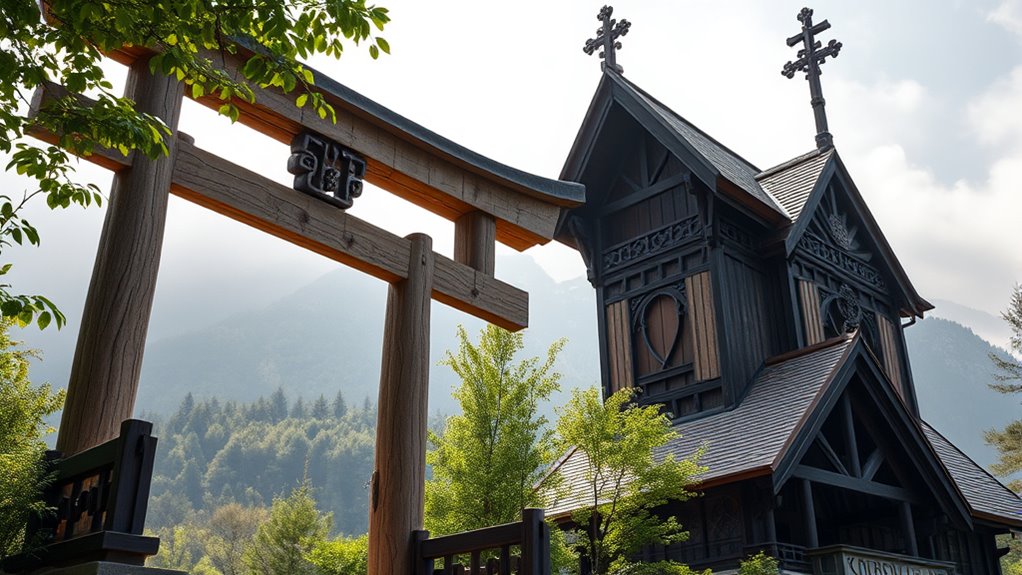
You can appreciate how these ancient wooden structures embody cultural and religious heritage, standing as symbols of their communities’ history. The Kizhi Pogost Church, Horyu Temple, and U Bein Bridge highlight craftsmanship and resilience across centuries. These masterpieces remind us of the enduring connection between architecture and cultural identity. Additionally, the use of traditional construction techniques and materials demonstrates the craftsmanship that has been preserved through generations, reflecting the traditional building methods passed down over time. The integration of Indigenous cultural practices into their design further emphasizes the deep-rooted significance of these structures in their communities’ histories. Recognizing the importance of sustainable building techniques helps preserve these historic sites for future generations, ensuring their cultural significance endures.
Ancient Architectural Masterpieces
Have you ever wondered how ancient builders crafted structures that have withstood centuries? These wooden structures showcase incredible ancient architecture, blending artistry and durability. The Kizhi Pogost in Russia, finished in 1862, is the tallest wooden structure in the world, built entirely from oak logs without metal support, with 22 domes reaching 123 feet. Japan’s Horyu Temple, over 1,300 years old, is the oldest surviving wooden building, made from 2,000-year-old Japanese cypress and designated a UNESCO World Heritage site in 1993. The Pagoda of Fogong Temple in China, dating back to 1056, rises about 220 feet and features timber from ancient craftsmanship. These monuments highlight how resilient wooden structures, like temples and pagoda, carry cultural significance across centuries. Additionally, the durability of these structures is often attributed to ancient craftsmanship techniques that combined skillful joinery and natural materials to ensure longevity.
Religious Cultural Heritage
Many of the world’s most revered religious sites are celebrated not only for their spiritual significance but also for their remarkable wooden architecture. These religious buildings showcase exquisite wooden ecclesiastical architecture, featuring intricate carpentry craftsmanship that has withstood centuries. The Kizhi Pogost Church in Russia, with its 22 domes and towering height, exemplifies this, representing a UNESCO World Heritage site. In Japan, Horyu Temple, over 1,300 years old and built from Japanese cypress, stands as the oldest surviving wooden structure, highlighting cultural heritage. The Great Buddha Hall of Tōdai-ji, once the largest wooden building, housed a giant bronze Buddha, reflecting the historical importance of wooden religious structures. These historic structures reveal resilience, artistry, and cultural significance that continue to inspire admiration worldwide.
Sustainable Wooden Buildings and Certifications
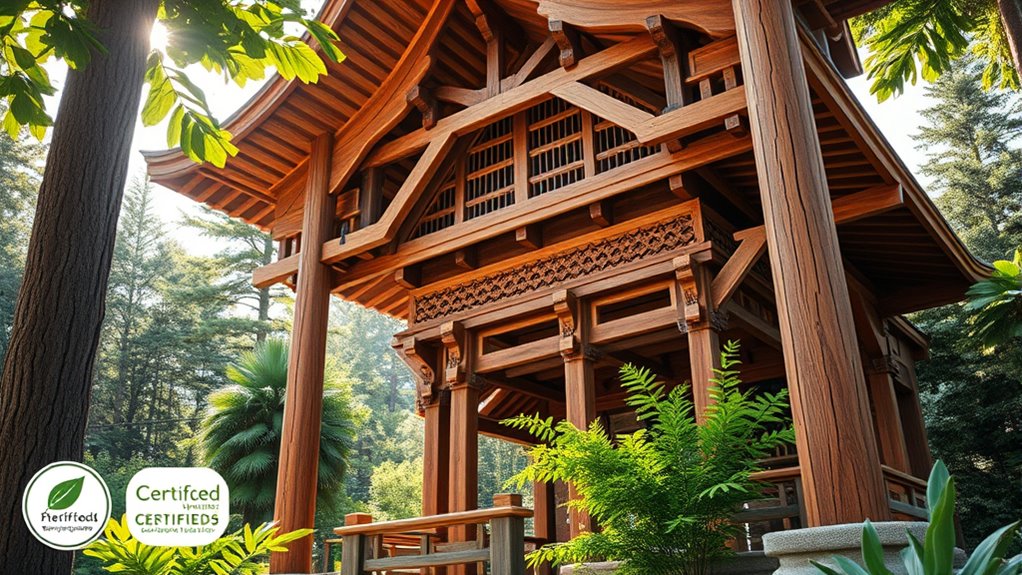
Sustainable wooden buildings are gaining recognition worldwide for their eco-friendly design and construction practices, often earning prestigious green certifications such as 5-Star Green-Star and ILBI Living Building status. When you choose structures built with FSC-certified timber, you support responsible forest management and reduce environmental impact. Here’s what makes these buildings stand out:
- They incorporate eco-friendly construction methods, emphasizing biodegradable materials and renewable energy sources.
- Rainwater recycling systems are commonly integrated to conserve water.
- Advanced insulation enhances energy efficiency, lowering carbon footprints.
- Certifications like Green-Star validate sustainable practices, ensuring project sustainability and eco-consciousness.
These features help promote sustainable wooden buildings as a viable, environmentally responsible option for modern architecture worldwide.
Innovative Design Techniques in Wooden Architecture
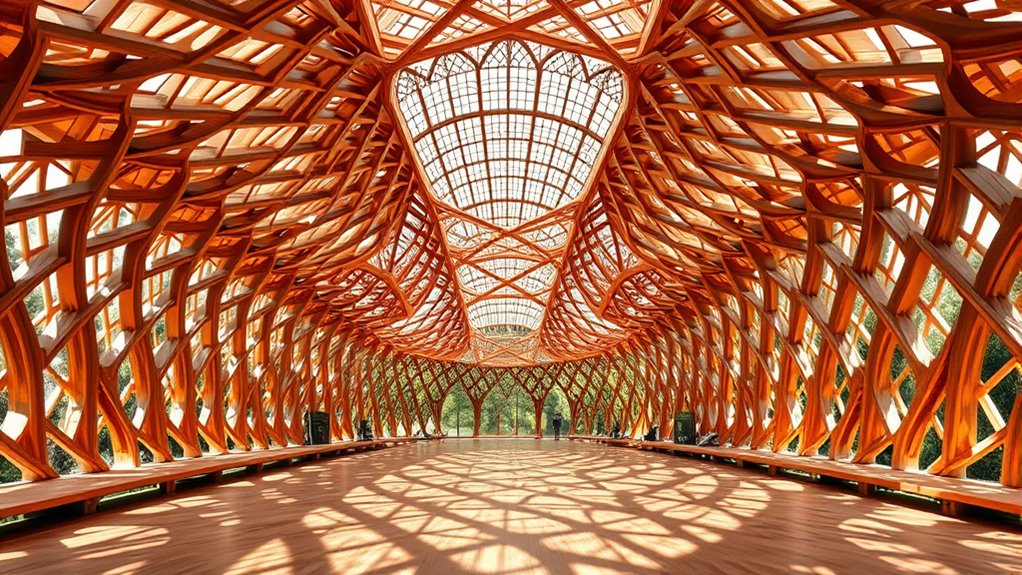
You’ll notice that modern wooden architecture employs advanced joinery methods, like the Jiigokugumi technique, to create seamless connections without glue or nails. Architects also harness cross-laminated timber (CLT) and innovative structural systems to build stronger, more resilient structures. These techniques not only improve performance but also showcase the beauty and versatility of wood in contemporary design.
Advanced Joinery Methods
Advanced joinery methods in wooden architecture push the boundaries of traditional craftsmanship by integrating innovative techniques that enhance both strength and beauty. You’ll see this in approaches like:
- Utilizing joinery techniques such as Jiigokugumi, which connect wooden slats without glue or nails.
- Employing lamination processes to create laminated beams and panels, boosting structural stability.
- Incorporating engineered products like CLT and LVL that rely on precise lamination and adhesive bonding for large, load-bearing components.
- Applying digital fabrication tools like CNC milling and CAD to craft intricate wooden joints, optimizing strength, aesthetics, and material use.
These methods demonstrate how modern innovations elevate traditional woodworking, enabling complex, durable, and visually striking wooden structures.
Cross-Laminated Timber Use
Building on innovative joinery techniques, modern architecture increasingly turns to cross-laminated timber (CLT) as a versatile and strong structural material. CLT panels, made from engineered wood, are prefabricated in factories, enabling rapid assembly on-site and reducing construction time. This technology empowers timber structures in high-rise construction, like the Ascent and Treet, showcasing its vertical potential. Using CLT supports sustainable building practices through carbon sequestration, renewable sourcing, and lower embodied energy compared to concrete and steel. Innovative design techniques include prefabricated modules, curved panels for aesthetic flexibility, and integrated insulation layers. These advancements foster eco-friendly, resilient, and visually striking architecture.
| Benefit | Impact |
|---|---|
| Sustainable building | Reduces carbon footprint |
| Prefabricated modules | Speeds up construction |
| Aesthetic flexibility | Enables creative architectural forms |
| High-rise potential | Replaces traditional materials |
| Eco-friendly materials | Supports green building goals |
Innovative Structural Systems
How do innovative structural systems transform wooden architecture into a resilient and versatile building material? They harness advanced techniques and materials like cross-laminated timber and high-strength timber to create strong, flexible structures. You can explore:
- Modular panels made from cross-laminated timber for faster assembly and design flexibility.
- Innovative joinery methods, such as Jiigokugumi, that connect timber precisely without nails or glue, preserving aesthetics and integrity.
- Hybrid systems combining wood with concrete or metal, like in timber skyscrapers, balancing sustainability and strength.
- Large-span roofs supported by dense timber beams, exemplified by structures like the Superior Dome, enabling expansive open spaces. These systems elevate wooden architecture, making it more resilient, sustainable, and architecturally versatile.
High-Rise Timber Buildings Pushing Boundaries
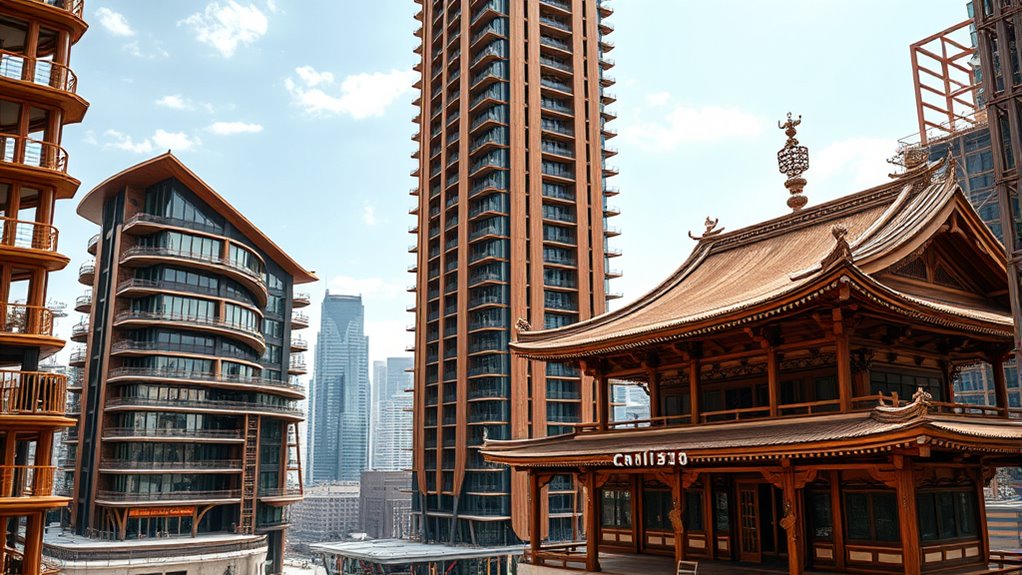
High-rise timber buildings are breaking new ground by reaching heights once thought impossible for wood structures. With advancements in mass timber and CLT technology, architects are pushing the limits of building height, creating impressive wooden skyscrapers. The Ascent in Milwaukee, completed in 2022, stands at 86.56 meters, making it the tallest mass timber building globally. Other projects like Norway’s Mjøstårnet and Austria’s HoHo Wien demonstrate how timber buildings can achieve significant height while showcasing innovative design. These structures exemplify architectural innovation, blending sustainability with urban development. As the trend continues, taller wooden skyscrapers are on the horizon, proving that timber can meet the demands of modern high-rise construction and redefine what’s possible in high-rise architecture.
Notable Wooden Temples and Religious Sites
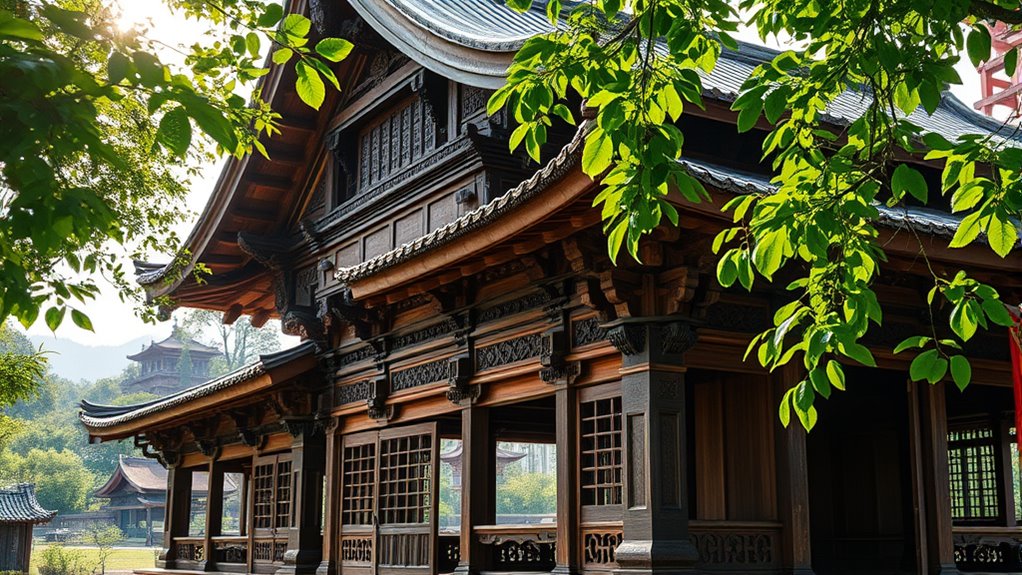
Did you know some of the world’s most remarkable wooden structures are centuries old, standing as tributes to craftsmanship and spiritual devotion? These notable wooden temples and religious sites highlight traditional architecture and durability. For example:
- The Horyu Temple in Japan, over 1,300 years old, features a five-story pagoda crafted entirely from Japanese cypress, making it the oldest surviving timber structure.
- The Kizhi Pogost on Kizhi Island, Russia, with its UNESCO-listed church and 22 domes, was completed in 1862 using only horizontal logs.
- The Pagoda of Fogong Temple in China, built in 1056, rises over 67 meters, showcasing resilience and intricate woodworking.
- Many of these religious buildings are celebrated for their historical significance, craftsmanship, and status as UNESCO World Heritage sites.
Unique Wooden Structures With Structural Innovations

You’ll see how engineers push the limits of wood with innovative joinery techniques, like glue and laminate, that eliminate nails and bolts. These structures combine advanced materials, such as cross-laminated timber and reinforced composites, to create remarkable heights and stability. Such feats highlight the ingenuity behind modern wooden architecture and its potential for sustainable, large-scale construction.
Advanced Structural Techniques
Advanced wooden structures push the boundaries of traditional craftsmanship through innovative joinery and engineering solutions. You’ll see this in how joinery techniques like Jiigokugumi connect wooden slats without glue or nails, exemplified by Kumamoto’s Pineapple House. Laminated timber and CLT panels are used in high-rise buildings such as Treet in Norway and Ascent in the US, offering strength and stability. The Superior Dome in Michigan features 781 Douglas fir beams and complex curved roofs, showcasing large-scale timber engineering. Additionally, structures like the ATLAS at Kirtland Air Force Base are built solely with glue, laminate, and fiberglass pegs, highlighting innovative construction methods. These techniques result in earthquake-resistant and resilient wooden frameworks, pushing the limits of what’s possible with timber.
Innovative Material Combinations
Innovative material combinations are transforming wooden structures by blending timber with other resilient materials like concrete and metal. These composites improve stability and durability, as seen in the Tall Wood Building in Vancouver, which integrates timber with concrete core walls for earthquake resistance. Techniques like cross-laminated timber (CLT) and laminated veneer lumber (LVL) enable large, load-bearing panels and complex high-rise designs. Glue-laminated components with fibreglass pegs enhance joint strength, while buckling-restrained brace frames improve seismic resilience. Engineered wood, such as curved LVL wind turbine towers, demonstrates how innovative material mixes support large-scale, high-performance applications. The table below highlights key innovations:
| Material Type | Application | Benefits |
|---|---|---|
| Composite materials | Tall buildings | Enhanced stability |
| Cross-laminated timber | High-rises | Load-bearing strength |
| Fibreglass pegs | Joinery | Durability and flexibility |
| Buckling-restrained frames | Seismic zones | Earthquake resilience |
Notable Engineering Feats
Have you ever wondered how engineers push the limits of wooden construction? They achieve remarkable engineering feats by developing innovative structural techniques in tall wood buildings. For example:
- The ATLAS at Kirtland Air Force Base is a 12-story, 1,000-foot wooden structure built with glue, laminate, and fiberglass pegs, demonstrating large-scale timber construction without nails.
- The Superior Dome’s 781 Douglas fir beams and 108.5 miles of decking showcase large-span roofing achieved through structural innovations in wood.
- The Wood Innovation Center employs laminated veneer lumber and timber shear walls, pushing the boundaries of tall wood buildings.
- The Miyazaki Wooden Tower aims to be the tallest wooden skyscraper, utilizing engineered timber and innovative joints. These feats redefine what’s possible with wooden structures.
Frequently Asked Questions
What Is the Biggest Wooden Structure in the World?
You’re wondering what the biggest wooden structure in the world is. Right now, the title goes to the Ark Encounter in Kentucky, which measures 500 feet long and uses 3.3 million boards of lumber. This massive construction showcases the impressive scale and durability of wood. Its size surpasses many other wooden buildings, making it a remarkable example of modern wooden architecture and engineering.
What Is the Oldest Wooden Structure?
Imagine stepping back in time to a humble yet resilient masterpiece of ancient craftsmanship. The oldest wooden structure you’d find is Japan’s Horyu-ji Temple, built between 600-700 AD. This historic site showcases centuries of skill, standing as a demonstration of enduring tradition. Its age and preservation highlight how skilled artisans used high-quality timber and careful techniques, allowing this wooden marvel to survive over a millennium, whispering stories of ancient Japan’s architectural ingenuity.
What Is the Oldest Wooden Building in the World?
You’re curious about the oldest wooden building in the world. The Horyu Temple in Japan, built around 607 AD, holds that title. You’d be amazed to learn it’s over 1,400 years old, showcasing exceptional Japanese carpentry skills. Its traditional wooden joints, without nails, and ancient cypress logs make it a remarkable survival, earning it recognition as Japan’s first UNESCO World Heritage Site.
What Is the Largest Wooden Structure in North America?
You’re asking about the largest wooden structure in North America. The Tillamook Air Museum in Oregon holds that title, featuring a massive 1,072-foot-tall clear-span hangar built during WWII. Its entirely wooden construction, with no internal supports, showcases impressive engineering. Since 1942, it’s served as an aircraft museum, highlighting wood’s strength and versatility in large-scale architecture, making it a remarkable example of functional wooden design on the continent.
Conclusion
You stand amid ancient temples carved from weathered wood, their timeless grace contrasting with soaring modern timber skyscrapers reaching skyward. While historic structures whisper stories of tradition, contemporary designs push boundaries, blending innovation with nature. As you observe these wooden marvels, you see a bridge between past and future—an enduring affirmation to human ingenuity and reverence for wood’s natural beauty. Together, they remind you that history and innovation walk hand in hand beneath the same wooden canopy.








